
- Homepage
- Certification
- Composition
- Denomination
- Ae Prutah (34)
- Ae3 (14)
- Antoninianus (104)
- Ar Denarius (42)
- Aurelianianus (12)
- Aureus (145)
- Bi Double Denarius (24)
- Bi Nummus (22)
- Centenionalis (16)
- Cistophorus (24)
- Denarius (1270)
- Double Denarius (63)
- Dupondius (16)
- Nummus (119)
- Prutah (27)
- Quadrigatus (13)
- Sestertius (127)
- Siliqua (15)
- Solidus (169)
- Tetradrachm (21)
- Other (604)
- Era
- Ruler
- Antoninus Pius (53)
- Augustus (141)
- Caracalla (53)
- Constantine I (57)
- Constantine Ii (29)
- Domitian (58)
- Gallienus (37)
- Gordian Iii (62)
- Hadrian (100)
- Marcus Aurelius (69)
- Nero (113)
- Nerva (31)
- Philip I (66)
- Septimius Severus (35)
- Severus Alexander (69)
- Theodosius Ii (32)
- Tiberius (69)
- Trajan (97)
- Trajan Decius (28)
- Vespasian (76)
- Other (1606)
- Year
POSTUMUS Authentic Ancient 262AD Cologne Original Roman Coin w MONETA NGC i82919
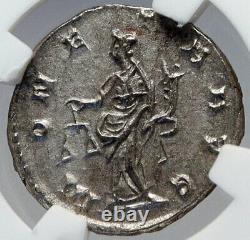
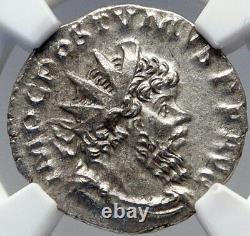
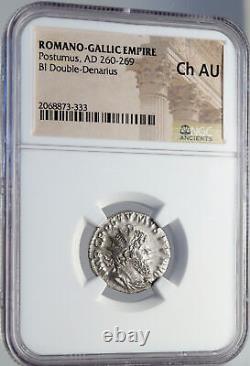
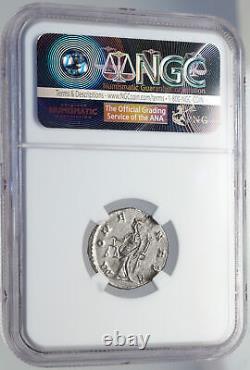
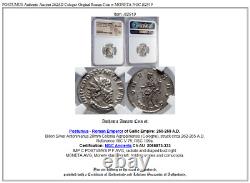


Of Gallic Empire: 260-268 A. Billon Silver Antoninianus 20mm Colonia Agrippinensis (Cologne), struck circa 262-265 A. Reference: RIC V 75; RSC 199a. Ch AU 2068873-333 IMP C POSTVMVS P F AVG, radiate and draped bust right. MONETA AVG, Moneta standing left, holding scales and cornucopia. Billon is an alloy of a precious metal (most commonly silver) with a majority base metal content (such as copper). It is used chiefly for making coins, medals, and token coins. The word comes from the French bille. The use of billon coins dates from ancient Greece through the Middle Ages. During the 6th and 5th centuries BC, some cities on Lesbos Island used coins made of 60% copper and 40% silver. Billon coins are perhaps best known from the Roman Empire, where progressive debasements of the Roman denarius and the Roman provincial tetradrachm. Juno Moneta, an epithet of Juno, was the protectress of funds. The Temple of Juno Moneta (Latin: Templum Iunonis Monetæ) was an ancient Roman temple that stood on the Arx or the citadel on the Capitoline Hill overlooking the Roman Forum. Located at the center of the city of Rome, it was the place where Roman coins were first minted, thereby initiating the ancient practice of associating mints with temples. In addition, it was the place where the books of the magistrates were deposited. In several modern languages including Russian and Italian, moneta (Spanish moneda) is the word for coin. " As with the goddess Moneta, Juno Moneta's name is derived either from the Latin monere, since, as protectress of funds, she "warned" of instability or more likely from the Greek "moneres" meaning "alone, unique, an epithet that every mother has. Marcus Cassianius Latinius Postumus was a Roman commander of provincial origin who ruled as emperor in the west. The Roman army in Gaul threw off its allegiance to Gallienus around the year 260, and Postumus assumed the title and powers of emperor in the provinces of Gaul, Germania, Britannia and Hispania, thereby founding what scholars have dubbed the Gallic Empire. He ruled for the better part of ten years before he was murdered by his own troops.
Little is known about the early life of Postumus. He has been claimed as a Batavian; certainly his coinage honours deities? Hercules Magusanus and Hercules Deusoniensis? Who would have been popular among the Batavians.
Hercules Magusanus was probably an interpretatio romana translation of the Germanic deity Donar. Deusoniensis may refer to the town of Deuso, located in or near Batavian territory and likely to be identified with Diessen; it has been hypothesized that Postumus himself was born in Deuso. From these relatively obscure provincial origins, Postumus would have risen through the ranks of the army until he held command of the Roman forces "among the Celts". What his precise title was is not definitely known, though he may plausibly have been promoted by the emperor Valerian to the position of imperial legate of Lower Germany. Postumus was evidently in favour at court, and, according to König, was granted an honorary consulship.
By 259, Valerian was campaigning in the east against the Persians, while his son and co-emperor Gallienus was preoccupied with the situation on the Danubian frontier. Consequently, Gallienus left his son, Saloninus, and military commanders, including Postumus, to protect the Rhine. Amid the chaos of an invasion by the Alamanni and Franks, and spurred on by news of the defeat and capture of Valerian, the army in Gaul revolted and proclaimed Postumus emperor.
The trigger was their defeat in 260 of a Juthungian army which was returning from Italy laden with prisoners, even though they had been repulsed by Gallienus at Mediolanum. Under the command of Postumus and Marcus Simplicinius Genialis, the Roman army crushed the Juthungi, and Postumus proceeded to distribute the captured spoils to the legions he commanded. Saloninus, on the advice of his praetorian prefect Silvanus (who had coordinated Roman policy in Gaul alongside Postumus), demanded the transfer of the recovered booty to his residence at Colonia Claudia Ara Agrippinensium (Cologne). Postumus assembled his army and made a show of reluctantly enforcing this command, thus inviting his troops to instead throw off their allegiance to Gallienus. The troops accordingly proclaimed Postumus emperor and proceeded to besiege and attack Colonia Claudia Ara Agrippinensium, trapping Saloninus and Silvanus. After breaching the walls of the city, Postumus had Silvanus and Saloninus killed, although his supporters later claimed that it was the native Gauls who were responsible for the murders. Later he erected a triumphal arch to celebrate his victory. Establishment of a Gallic empire. Postumus was immediately recognized as emperor in Gaul (except perhaps for Narbonensis), the two Germanias, and Raetia. By 261, Britannia, Gallia Narbonensis and Hispania had also acknowledged him as emperor, possibly after an expedition to Britain in the winter of 260/261. He established his capital in northern Gaul, probably at Colonia Claudia Ara Agrippinensium or Augusta Treverorum, and then proceeded to set up many of the traditional Roman legislative and executive structures. Apart from the position of emperor, he immediately assumed the office of consul alongside a colleague, Honoratianus.Like his imperial predecessors, he became the pontifex maximus of the state and assumed tribunician power each year. He is thought to have established a senate, perhaps on the basis of the Council of the Three Gauls or provincial councils, and a praetorian guard, one of whose officers was to become the future Gallic emperor Victorinus. Reflecting his power base, the chief members of Postumus' administration appeared to have been of northern Gallic origin, and indeed, the entire administration soon became rapidly Gallicized. Both Victorinus and Tetricus, important members of the government, hailed from this region. Postumus represented himself as the restorer of Gaul (Restitutor Galliarum) and the bringer of security to the provinces (Salus Provinciarum) on some of his coins; prior to 10 December 261, he also took the title of Germanicus maximus, a title he earned after successfully defending Gaul against the Germans.
His principal objective in assuming the purple appeared to be the restoration and defence of the Rhine frontier and the surrounding area, a task that he approached with vigour, earning the admiration of the ancient authors, who declared that he restored the security that the provinces had enjoyed in the past. So successful was he in the task of restoring peace and security to the provinces under his direct control that the coins issued by Postumus were of better workmanship and higher precious metal content than coins issued by Gallienus; his control of the Spanish and British mining regions was presumably crucial in this regard, as was his employment of master minters who would have come into Gaul with Gallienus. Postumus fought successful campaigns against the Franks and Alamanni in 262 and 263; following his victory over them in 263, he assumed the title Germanicus Maximus, after which his coin-types celebrated peaceful themes such as Felicitas Augusti for some time. After having spent much of the last four years pushing the Franks out of Gaul, Postumus then recruited Frankish troops to fight against other Franks, probably dispersed within existing Roman army units. Scholars continue to debate whether Postumus originally intended to dislodge Gallienus from Rome or was content to rule only the western provinces. Postumus' powerbase was Gaul and his main responsibility was the defense of the Rhine provinces.If he marched against Gallienus, then he would be exposing his heartland not only to the Germanic tribes but also potentially to any number of usurpers. Perhaps he hoped to achieve some official recognition from Gallienus; what is clear, however, is that Postumus was not overtly separatist and did not revive the 1st-century dream of an independent Galliarum imperium. See Julius Sabinus and revolt of the Batavi.
The forms, titles, and administrative structures of Postumus' principate remained conventionally Roman. For four years Gallienus had been too distracted by Germanic invasions and other usurpers in the east to turn his attention to the situation to his north and west. This changed in 265 when Gallienus launched a campaign to defeat Postumus. After some initial success against Postumus, his first attempt failed when Postumus managed to escape from a precarious situation due to the carelessness of Gallienus' cavalry commander Aureolus, leading to Aureolus' demotion and eventual abandonment of Gallienus in 267. A second campaign, led by Gallienus himself, also seemed to have the advantage over Postumus, but while Gallienus was besieging a city in Gaul (perhaps Augusta Treverorum), he was wounded and forced to withdraw. After his failed attempt at defeating Postumus, Gallienus was occupied with crises in the rest of his empire and did not confront Postumus again. Gallienus nevertheless did manage to wrest control of Raetia from Postumus during these years. By the end of 265, Postumus' coin issues were triumphantly commemorating the victory over Gallienus, and the festivities celebrating his quinquennalia continued into the following year. Very little troubled the reign of Postumus from 265 to 268; archaeological evidence, such as it is, points to a general return to peace and normalcy. In 266, Postumus became consul for the fourth time, taking as his colleague Marcus Piavonius Victorinus, a Gallic noble who was also a senior military officer; his selection to such a high-profile position may be seen as an attempt to broaden Postumus' base of support. The year 268 saw the issuing of the'Labours of Hercules' series of gold coins in honour of Postumus' favourite god.Such discontent must probably have been due to the army's frustration with Postumus' failure to take advantage of a golden opportunity to move against Gallienus in 268. Aureolus, the general who was in command of Mediolanum in Gallienus' interest, rebelled and ultimately declared for Postumus. The city of Mediolanum and its north Italian and Raetian hinterland would have been critical to Postumus if he planned to march on Rome.
For whatever reason, Postumus failed to support Aureolus, who was besieged by Gallienus. Before the end of the northern summer in 268, the events at Mediolanum were to see the assassination of Gallienus, the defeat of Aureolus, and the accession of Claudius II. It also triggered a sequence of events that would see the end of Postumus' rule in Gaul.Postumus assumed his fifth consulship on 1 January 269, but the army in Germania Superior raised a usurper in early 269. Laelianus, one of Postumus' top military leaders and the governor of Germania Superior, was declared emperor in Mogontiacum by the local garrison and surrounding troops (Legio XXII Primigenia).
Although Postumus was able to capture Mogontiacum and kill Laelianus within a few months, he was unable to control his own troops, who wished to put Mogontiacum to the sack. When Postumus tried to restrain them, his men turned on him and killed him. The mutineers set up Marius, a common soldier, as emperor. Marius held sway for a short while before being overthrown by Victorinus, Postumus' erstwhile colleague in the consulship and tribune of the praetorian guard. In the meantime, the Gallic Empire lost Spain.
Postumus has been of particular interest to numismatists, in light of the high quality and relative abundance of his coin issues. His'Labours of Hercules' series is particularly renowned. The Gallic Empire (Latin: Imperium Galliarum) is the modern name for a breakaway part of the Roman Empire that functioned de facto as a separate state from 260 to 274. It originated during the Crisis of the Third Century.It was established by Postumus in 260 in the wake of barbarian invasions and instability in Rome, and at its height included the territories of Germania, Gaul, Britannia, and (for a time) Hispania. After Postumus' assassination in 268 it lost much of its territory, but continued under a number of emperors and usurpers. It was retaken by Roman emperor Aurelian after the Battle of Châlons in 274. The Roman Crisis of the Third Century continued as the Emperor Valerian was defeated and captured by the Sassanid Empire of Persia in the Battle of Edessa, together with a large part of the Roman field army in the east.
This left his son Gallienus in very shaky control. Shortly thereafter, the Palmyrene Empire, which came to encompass Egypt, Syria, Judea, and Arabia Petraea also broke away. The governors in Pannonia staged unsuccessful local revolts. The Emperor left for the Danube to attend to their disruption.
This left Postumus, who was governor of Germania Superior and Inferior, in charge at the Rhine border. An exceptional administrator, Postumus had also protected the Germania Inferior against an invasion led by the Franks in the summer of 260 very well.
In fact, Postumus defeated the Frankish forces at Empel so decisively, that there would be no further Germanic raids for 10 years. This all would have combined to make Postumus one of the most powerful men in the western reaches of the Roman empire.The Gallic Empire at its greatest territorial extent, after its creation by Postumus in 260 A. The imperial heir Saloninus and the praetorian prefect Silvanus remained at Colonia Agrippina (Cologne), to keep the young heir out of danger and perhaps also as a check on Postumus' ambitions. Before long, however, Postumus besieged Colonia Agrippina and put the young heir and his guardian to death, making his revolt official. Postumus is thought to have established his capital at Cologne or Augusta Treverorum (Trier), with Lugdunum (Lyon) also becoming an important city in the empire. The Gallic Empire had its own praetorian guard, two annually elected consuls (not all of whose names have survived) and probably its own senate.
According to the numismatic evidence, Postumus himself held the office of consul five times. Postumus successfully fended off a military incursion by Gallienus in 263, and was never challenged by him again. However, in early 268 he was challenged by Laelianus, probably one of his commanders, who was declared emperor at Mogontiacum (Mainz) by his Legio XXII Primigenia.
Postumus quickly retook Mogontiacum and Laelianus was killed. Postumus himself, however, was overthrown and killed by his own troops, reportedly because he did not allow them to sack the city. After the death of Postumus, the Gallic Empire began to decline. Roman Emperor Claudius Gothicus re-established Roman authority in Gallia Narbonensis and parts of Gallia Aquitania, and there is some evidence that the provinces of Hispania, which did not recognize the subsequent Gallic Emperors, may have re-aligned with Rome then.
Marius was instated as Emperor upon Postumus' death, but died very shortly after; ancient sources writing much later state that he reigned only two days, though it is more likely, as displayed through the numismatic record, that he reigned for a few months. Subsequently Victorinus came to power, being recognized as Emperor in northern Gaul and Britannia, but not in Hispania. Victorinus spent most of his reign dealing with insurgencies and attempting to recover the Gaulish territories taken by Claudius Gothicus. He was assassinated in 271, but his mother Victoria took control of his troops and used her power to influence the selection of his successor. With Victoria's support, Tetricus was made Emperor, and was recognized in Britannia and the parts of Gaul still controlled by the Empire. Tetricus fought off Germanic barbarians who had begun ravaging Gaul after the death of Victorinus, and was able to re-take Gallia Aquitania and western Gallia Narbonensis while Roman Emperor Aurelian was engaging Queen Zenobia's Palmyrene Empire in the east. He established the imperial court at Trier, and in 273 he elevated his son, also named Tetricus, to the rank of Caesar.The following year the younger Tetricus was made co-consul, but the Empire grew weak from internal strife, including a mutiny led by the usurper Faustinus. By that time Aurelian had defeated the Palmyrene Empire and had made plans to re-conquer the west.
This detail may be later propaganda, but either way, Aurelian was victorious, and the Gallic Empire was effectively ended. World-renowned expert numismatist, enthusiast, author and dealer in authentic ancient Greek, ancient Roman, ancient Byzantine, world coins & more. Ilya Zlobin is an independent individual who has a passion for coin collecting, research and understanding the importance of the historical context and significance all coins and objects represent. Send me a message about this and I can update your invoice should you want this method. Getting your order to you, quickly and securely is a top priority and is taken seriously here.Great care is taken in packaging and mailing every item securely and quickly. What is a certificate of authenticity and what guarantees do you give that the item is authentic?
You will be very happy with what you get with the COA; a professional presentation of the coin, with all of the relevant information and a picture of the coin you saw in the listing. Additionally, the coin is inside it's own protective coin flip (holder), with a 2x2 inch description of the coin matching the individual number on the COA. Whether your goal is to collect or give the item as a gift, coins presented like this could be more prized and valued higher than items that were not given such care and attention to.
When should I leave feedback? Please don't leave any negative feedbacks, as it happens sometimes that people rush to leave feedback before letting sufficient time for their order to arrive. The matter of fact is that any issues can be resolved, as reputation is most important to me. My goal is to provide superior products and quality of service. How and where do I learn more about collecting ancient coins? Visit the Guide on How to Use My Store. For on an overview about using my store, with additional information and links to all other parts of my store which may include educational information on topics you are looking for. This item is in the category "Coins & Paper Money\Coins: Ancient\Roman: Imperial (27 BC-476 AD)".The seller is "highrating_lowprice" and is located in this country: US. This item can be shipped worldwide.
- Certification Number: 2068873-333
- Certification: NGC
- Grade: Ch AU
- Composition: Billon
- Ruler: Postumus
- Denomination: Denomination_in_description
- Year: Year_in_description

